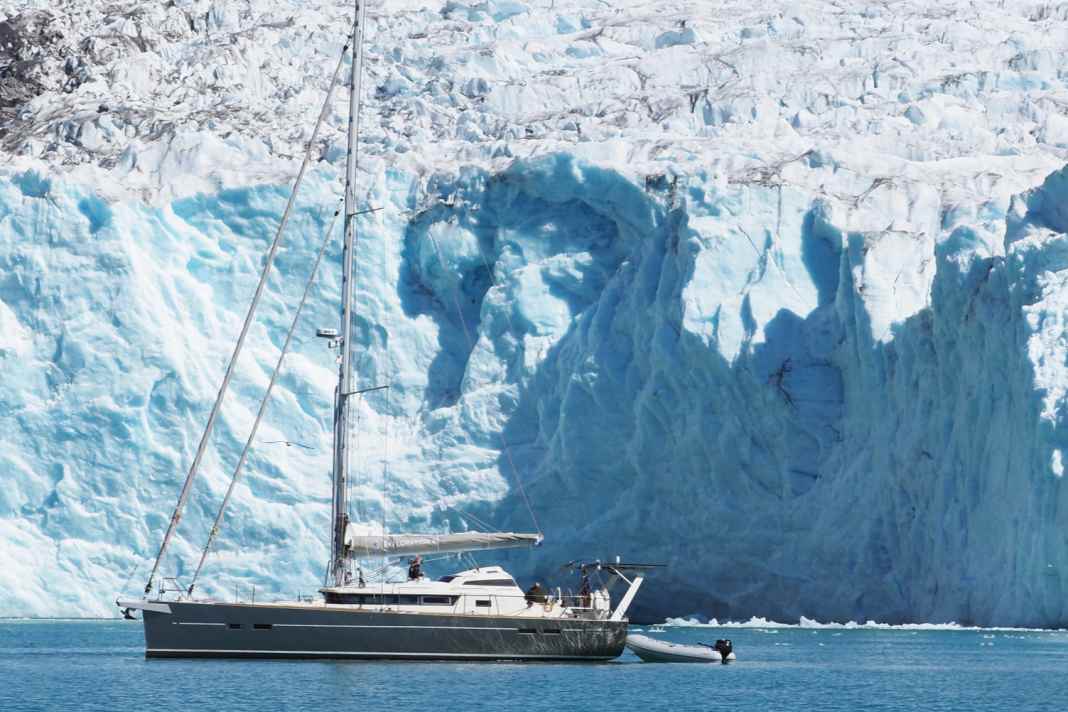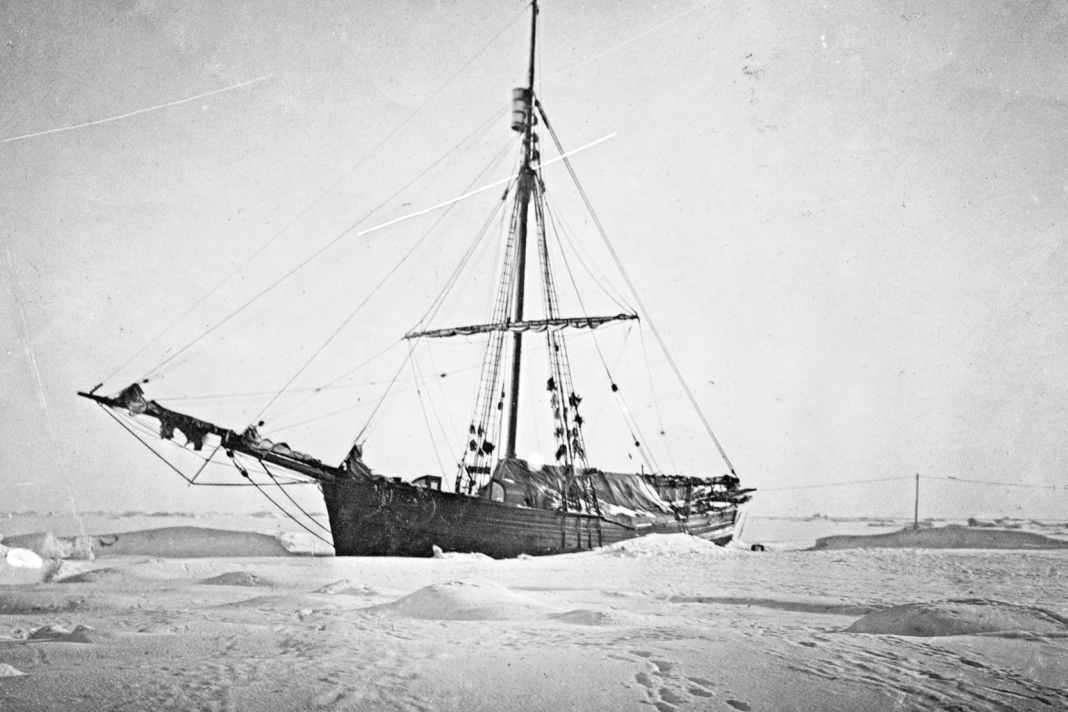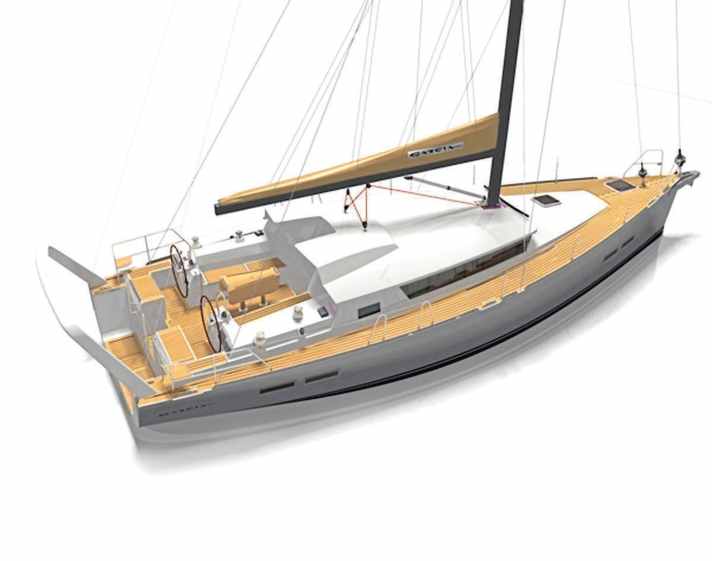Northwest Passage: Dangerous route through the ice with three Garcia yachts
Fabian Boerger
· 16.02.2025






- No waterway has been sought for as long as the Northwest Passage
- Ice-free conditions in the Northwest Passage vary greatly
- Travelling by chance in a parcel
- Third Garcia wants to sail the Northwest Passage in 2024
- Difficult passage through Ballotstrasse
- Next stop: Antarctica
- Northwest Passage, an adventure for adventurers
- A boat for remote areas
They have been waiting for this moment for days. The infamous Bellot Strait, a strait around 18 nautical miles long and only a few hundred metres wide in the Arctic-Canadian archipelago, lies before them - and it is open! The sea ice, which normally blocks the passage like a thick blanket, has become brittle. For Adriano Viganò and Marisa Lankester, who want to cross the Northwest Passage with their Garcia Exploration 45 "Voyager", this is their chance!
Under engine power, they move slowly westwards, piece by piece, through gullies that have become free between drifting patches of ice. High, barren rock faces rise up on both sides. In this strait, where water masses from east and west meet, the current is usually extremely strong. Only on a few days is the sea calm here and passage possible.
Read also:
On this day, that is exactly the case. The pair make good progress, working their way past the ice. Suddenly, however, a French boat behind them sends out a distress call. It has become stuck between drifting floes and the masses of ice begin to press against the hull - so hard that the boat is pushed out of the water like a cork from a bottle and tips to one side. But that's not all, because a whirlpool forms over Magpie Rock, a treacherous shoal that lies directly under the hull. "It spun the boat round and round like a toy," recalls Lankester. Panic spreads among the crew. The Swiss did not hesitate, turned back and came to the aid of the Frenchmen in distress.
Fortunately, the moment of shock is short-lived. After a while, the ice loosens its grip and releases the boat. The ice leaves a large dent in the aluminium hull, but the crew remains unharmed. In the meantime, however, the ice cover in the Bellot Strait has closed again. For Viganò and Lankester, this once again means: wait!
No waterway has been sought for as long as the Northwest Passage
The Bellot Strait is one of many narrow passages that all those who want to cross the legendary Northwest Passage must pass through. It leads through the Arctic Ocean and numerous straits of the Canadian Arctic Archipelago. It has fascinated explorers, adventurers and daredevils for centuries. No navigable waterway has been sought for as long as the Northwest Passage, as it promises a much shorter route between Europe and Asia than the route around South Africa and through the Indian Ocean.
The Norwegian polar explorer Roald Amundsen was the first person to successfully cross the Northwest Passage in 1906. He spent the winter in the ice twice with his "Gjøa". About half a century earlier, the British adventurer Sir John Franklin had already searched for the passage, but he died during the attempt in 1847. The exact circumstances of his death have not yet been conclusively clarified. It is suspected that he died from gradual lead poisoning, as the tinned food the crew ate was once soldered with lead. The only certainty is that all 129 members of his crew perished. The ships of the expedition, the "Erebus" and the "Terror", also remained lost for decades. It was only a few years ago that they were discovered on the seabed west of King William Island thanks to the use of state-of-the-art sonar technology.
Nowadays, the routes of the Northwest Passage are increasingly passable by ship. However, the sea route only remains ice-free for a short period of the year, usually a few days to a few weeks in late summer to autumn. The progressive decline in sea ice, which scientists attribute to climate change, makes this possible. Experts expect that the number of ice-free days will increase significantly in the coming years and that they could start earlier.
Ice-free conditions in the Northwest Passage vary greatly
Advances in navigation and technology are also helping to significantly reduce potential dangers. Nevertheless, the route remains difficult. On the one hand, it requires the best navigational skills as well as specialised sea and ice charts in order to cross the sometimes shallow and narrow archipelago safely. Secondly, the probability of encountering closed ice, even in summer, is very high. The ships must therefore be built to be ice-strengthened. In addition, the freedom from ice varies greatly. As a result of global warming, the thick sea ice is melting faster, but this means that it breaks up more easily. This makes it easier for ice floes, fragments of icebergs and large pack ice fields to be pushed into narrow sea lanes and block them.
Adriano Viganò and Marisa Lankester also experience this when they want to cross the Bellot Strait on their journey through the Northwest Passage in August 2024. It was not clear to them from the outset that they would even be able to complete the Northwest Passage.
Their adventure begins in July 2023. They both want a break, are looking for an adventure and decide to sail around the world. He, 64 years old, is a lawyer and consultant and worked for a time in the Swiss cinema industry. She, 62 years old, is originally from Canada, lived in the USA for a long time, now lives in Switzerland and is a writer.
The couple sell most of their possessions, store the rest in a garage and move onto the boat once their "Voyager" is finished. It was clear from the outset that it would be just such a Garcia for travelling around the world. "It was the aluminium boat with the clearest and most advanced deck saloon concept," explains Viganò. Garcias are known for their high level of safety and robustness and are suitable for both tropical and arctic waters. They are built to reach remote places.
Travelling by chance in a parcel
They realised they had made the right decision as early as the test sail on the North Sea, after several days of strong winds. The hull is designed to withstand large waves and rough seas without any problems. "You reef a little and just let the boat run. It copes incredibly well with heavy weather," says Viganò. The test trip is followed by the Atlantic crossing. They will spend the winter in the Caribbean. From there, they plan to sail around the world through the Panama Canal on the barefoot route.
But problems arise in Panama; the passage through the canal is delayed. So they think: "This must be a sign that we should head north-west." In the end, they decide to head north along the east coast of the US. From Virginia via New York City, they travelled to Canada, Nova Scotia and finally to Newfoundland. In St Johns, they are joined by Sean and Kate Collins, who also own a Garcia. From now on, the four of them want to cross the Northwest Passage.
From Newfoundland, they sail through the Davis Strait, the southern part of the Arctic Ocean, and further north into Baffin Bay. It takes them eight days to reach Nuuk, the capital of Greenland. From there, they continue up the west coast, then across Baffin Bay and via Pond Inlet into Lancaster Sound and later south into Prince Regent Inlet.
Many of these areas are inadequately mapped or not mapped at all. Fog and icebergs are constant companions, and iceberg watches become routine. It is summer in the Arctic when they cross the Arctic Circle. The sun no longer sets at night. Nevertheless, the temperatures are often around freezing point and the mountains on the shore are covered in snow.
"It's fantastic and surreal," says Viganò looking back. He is amazed by the beauty of nature and raves about the remoteness. "I mean, you're in a completely different environment, surrounded by whales, walruses and polar bears." Beluga whales swim alongside the boat; a narwhal is born in the water right next to them. "It's inhospitable. The landscape is so vast, almost endless," adds Viganò.
Third Garcia wants to sail the Northwest Passage in 2024
Marisa Lankester shares the enthusiasm. "For me as a Canadian, it was a lifelong dream to visit Fort Ross, this iconic Hudson Bay Company hut at the end of the world." The abandoned trading post is located at the eastern entrance to the Bellot Strait. It is the place where they wait for days to pass through. Countless sailors have immortalised themselves and the names of their boats there over the last few decades. The names of the "Voyager" crew are now also written there.
Fort Ross is also a symbolic place for Brit Tom Sperrey, 74. In 2022, he bought a Garcia Exploration 45, the "Night Owl", with the aim of crossing the Northwest Passage. "But if I'm honest, my real goal was to have my photo taken in front of the abandoned Hudson Bay building, Fort Ross," says Sperrey. Achieving this goal was already a success for him. Together with the British meteorologist Chris Tibbs, who himself has travelled around the world several times, he set off on his journey at the same time as the "Voyager".
They meet up several times on the way, and the "Night Owl" crew also has to battle with ice in front of Bellotstrasse. "I think everyone who does this is a bit crazy and wants to test the limits," says Sperrey. He thinks the passage could be one of the last remaining adventures left these days. "It remains a challenge to drive through it," says Sperrey.
And for many reasons: The conditions are often unpredictable. The weather changes quickly and unexpectedly; the ice surfaces are constantly changing shape and size. Routes have to be regularly adjusted and decisions reconsidered. But once there, there is no way out and no harbours to replenish provisions or carry out repairs. You have to do everything yourself en route.
Difficult passage through Ballotstrasse
Adriano Viganò and Marisa Lankester also knew that it would be difficult. But there was one thing they wanted to avoid at all costs: being trapped by the ice and having to spend the winter in the Arctic. Lankester: "That was something we wanted to avoid at all costs. Winters here are not like in Europe. We're talking minus 40 to 50 degrees, darkness, storms and the like."
But ice is still blocking their path. Bellotstrasse closed the gates after the first attempt, the ice had pushed them further and further back. Whether they would get a second chance is uncertain at this point. "There was so much ice that I thought we wouldn't get through," says Viganò. It was a difficult time. "Demoralising," adds Lankester. But then, when they almost stopped believing, a new window opened for them.
A snowstorm pushes the ice aside and clears the strait. But the conditions are anything but ideal. The storm also rages across them, churning up the sea and making the passage increasingly difficult. "At some point, there is a huge feeling of elation when you know that there is no turning back now. You can only go forwards now," says Lankester. They finally make it and pass the Bellot Strait - but it remains uncomfortable.
The persistent wind causes the ice to pile up again. "The whole sea was full of it, there was no bay to seek shelter in," says Viganò. So from the exit of the Bellot Strait, they follow an ice-free passage very close to the rocky coast. They continue their journey southwards and pass the western side of King William Island. This is exactly where the ships of the Franklin expedition once got stuck. More than a century later, they were discovered on the seabed.
The tension only eases when the Swiss reach the eastern Beaufort Sea after Cambridge Bay. They have made it and left the Canadian archipelago behind them. The next best place they can call at is Tuktoyaktuk. The small community in the far north-west of Canada has only around 1,000 inhabitants. Nevertheless, it is an important stopover for travellers on the Northwest Passage. Supplies can be replenished here or, with a bit of luck, fuel can be bunkered. Since 2017, there has also been a year-round road connection inland. Sean and Kate Collins leave the "Voyager" here.
Next stop: Antarctica
Adriano Viganò and Marisa Lankester continue their journey. They leave Canadian waters and sail further west along the north coast of Alaska. For several days they struggle with difficult conditions. After a few days, they round Point Barrow and reach the Bering Strait - a narrow passage between the continents of Asia and North America - via the Chukchi Sea. At this point, the Russian mainland and Alaska are only about 88 kilometres apart. From there, the journey continues to the city of Nome, the official end of the Northwest Passage, and through the Aleutian Island chain to Kodiak.
"When we lifted the boat out of the water in Kodiak, we thought that after the journey with all the ice, the hull would be full of scratches and dents and you would be able to see the distance," says Viganò. But there is nothing. After twelve weeks in the wake of the Northwest Passage, the aluminium hull looks almost as it did when they left. Ice and swell have done nothing to harm the boat - or the crew, apparently.
They plan to return to "Voyager" in March; they will spend the winter at home. From now on, they want to take it easy, they say. But the next ice adventure is already on the horizon. After Hawaii, the Pacific Islands and New Zealand, Antarctica is on their wish list. They have shown that they and their ship are capable of mastering such a challenge.
Northwest Passage, an adventure for adventurers




The first successful crossing by Roald Amundsen and his "Gjøa" was completed in 1906. Since then, according to the Scott Polar Research Institute at Cambridge University, 430 complete passages by ships of all kinds have been counted. In 2024, there were 38: in addition to commercial ships such as freighters and icebreakers (10) and cruise ships (8), sailing and motor yachts (20) made up the largest proportion.
The first Germans were Arved Fuchs with the "Dagmar Aaen" and Clark Stede with "Asma" in 1993. Fuchs managed it again in 2004. In total, at least 14 boats flying the German flag have completed the passage to date, including Susanne Huber-Curphey. The exceptional sailor mastered the passage single-handedly in 2017.
The Scott Polar Research Institute lists seven route options for the Northwest Passage. A distinction is also made between the direction in which the journey takes place. From east to west, the adventure starts in the Davis Strait south-west of Greenland. This is followed by several straits within the Arctic-Canadian archipelago. Then it's across the Beaufort Sea, the Chukchi Sea and finally the Bering Sea into the Pacific.
From the entrance to the Davis Strait to the strait in the Bering Sea, the passage is between 2,860 and 3,560 nautical miles long, depending on the route. It is only considered complete once you have crossed the Arctic Circle once in the west and once in the east.
A boat for remote areas

Garcia yachts are designed to reach the most remote places in the world. They are semi-customs and are built in a small shipyard in Normandy, France. The concept of the Exploration 45 was developed in collaboration with blue water pioneer and founder of ARC, Jimmy Cornell. His 40 years of expertise in long-distance sailing played a key role in the project.
Proof of the yachts' performance is the successful crossing of the Northwest Passage by three Garcias in the summer of 2024: the "Voyager" (Switzerland), the "Night Owl" (Great Britain) and the "Hauru" (Poland). Thanks to the aluminium hull and double insulation, the boats are suitable for both warm and cold regions. The windows are double-glazed and the companionway door is watertight. The boat heats up well even at temperatures below zero.
Instead of a classic keel, it has a lifting centreboard, which allows the draught to be reduced to just one metre. This makes it possible to travel in shallow, coastal waters and also in estuaries.
The saloon deck is particularly advantageous in bad weather, as many tasks can be carried out from inside. The cockpit is also very well protected and partially covered by a hardtop. Most sailing manoeuvres can be carried out by the crew in this protected area.
The designers also emphasised autonomy: large water and fuel tanks enable the crew to remain independent for long periods of time. The ships can also be equipped with solar, wind and hydrogen generators to produce electricity. Plenty of this is needed to operate the refrigerator, water maker, autopilot and many other devices.
Technical data of the Garcia Exploration 45
- Design engineer: Olivier Racoupeau
- Model: Garcia Exploration 45
- Torso length: 13,98 m
- Width: 4,43 m
- Tiefg. (w./o. sword): 2,80/1,05 m
- Weight: 14,1 t
- Ballast/proportion: 4,5 t/32 %
- Mast height: 19,40 m

